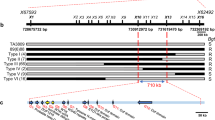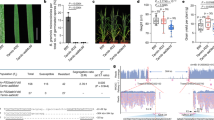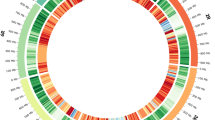Abstract
Two mildew resistant accessions of diploid Aegilops squarrosa and their hexaploid synthetics derived from crosses with mildew susceptible Triticum durum cultivars were tested with differential isolates of Erysiphe graminis f. sp. tritici and their responses were compared with the response patterns of 16 wheat cultivars or lines possessing known mildew resistance genes. Resistance in the A. squarrosa accession ‘Braunschweig BGRC 1458’ was conditioned by the dominant gene Pm2. This gene confers the same response pattern with a set of mildew isolates when present at the diploid species level or in a hexaploid synthetic with T. durum. It was located on wheat chromosome 5D. The resistance gene in the A. squarrosa accession ‘Gatersleben AE 457/78’ showed a different response pattern in the hexaploid synthetic line ‘XX 186’ tested with mildew isolates compared with that of the diploid. Its response pattern was also different from all other wheats with named genes for resistance to powdery mildew. The gene, localized on chromosome 7D in the synthetic ‘XX 186’, was designated Pm19.
Similar content being viewed by others
Article PDF
References
Allard, R W, and Shands, R G. 1954. Inheritance of resistance to stem rust and powdery mildew in cytologically stable spring wheats derived from Triticum timopheevii. Phytopathology, 44, 266–274.
Briggle, L W. 1966. Three loci in wheat involving resistance to Erysiphe graminis f. sp. tritici. Crop Sci, 6, 461–465.
Briggle, L W. 1969. Near-isogenic lines of wheat with genes for resistance to Erysiphe graminis f. sp. tritici. Crop Sci, 9, 70–72.
Ceoloni, C, Del Signore, G, Ercoli, L, and Donini, P. 1992. Locating the alien chromatin segment in common wheat-Aegilops longissima mildew resistant transfers. Hereditas, 116, 239–245.
Cox, T S, Raupp, W J, Wilson, D L, Gill, B S, Leath, S, and Browder, L E. 1992. Resistance to foliar diseases in a collection of Triticum tauschii germ plasm. Plant Disease, 76, 1061–1064.
Driscoll, C J, and Anderson, L M. 1967. Cytogenetic studies of Transec — a wheat-rye translocation line. Can J Genet Cytol, 9, 375–380.
Frauenstein, K, and Hammer, T. 1985. Prüfung von Aegilops-Arten auf Resistenz gegen Echten Mehltau, Erysiphe graminis DC Braunrost, Puccinia recondita Rob. ex Desm., und Spelzenbräune, Septoria nodorum Berk. Kulturpflanze, 33, 155–163.
Friebe, B, Heun, M, Tuleen, N, Zeller, F J, and Gill, B S. 1994. Cytogenetically monitored transfer of powdery mildew resistance from rye into wheat. Crop Sci, 34, 621–625.
Gill, B S, Raupp, W J, Sharma, H C, Brouder, L E, Hatchett, J H, Harvey, T L, Moseman, J G, and Waines, J G. 1986. Resistance in Aegilops squarrosa to wheat leaf rust, wheat powdery mildew, greenbug and Hessian fly. Plant Disease, 76, 553–556.
Heun, M, and Friebe, B. 1990. Introgression of powdery mildew resistance from rye into wheat. Phytopathology, 80, 242–245.
Jaaska, V. 1981. Aspartate aminotransferase and alcohol dehydrogenase isoenzymes: intraspecific differentiation in Aegilops tauschii and the origin of the D genome polyploids in the wheat group. Pl Syst Evol, 137, 259–273.
Jørgensen, J H, and Jensen, C J. 1972. Genes for resistance to wheat powdery mildew in derivatives of Triticum timopheevii and Triticum carthlicum. Euphytica, 21, 121–128.
Lagudah, E S, and Halloran, G M. 1988. Phylogenetic relationships of Triticum tauschii, the D genome donor to hexaploid wheat. 1. Variation in HMW subunits of glutenin. Theor Appl Genet, 75, 592–598.
Law, C N, and Wolfe, M S. 1966. Location for genetic factors for mildew resistance and ear emergence time on chromosome 7B of wheat. Can J Genet Cytol, 8, 462–470.
Lutz, J, Hsam, S L K, Limpert, E, and Zeller, F J. 1994. Powdery mildew resistance in Aegilops tauschii Coss. and synthetic hexaploid wheats. Genet Res Crop Evol, 41, 151–158.
McIntosh, R A. Catalogue of gene symbols for wheat. In: Proceedings of 8th International Wheat Genetics Symposium, Beijing, China (in press).
McIntosh, R A, and Baker, E P. 1970. Cytogenetical studies in wheat. IV. Chromosome location and linkage studies involving the Pm2 locus for powdery mildew resistance. Euphytica, 19, 71–77.
Mains, E B. 1933. Host specialization of Erysiphe graminis tritici. Proc Natl Acad Sci USA, 19, 49–53.
Miller, T E, Reader, S M, Ainsworth, C C, and Summers, R W. 1988. The introduction of a major gene for resistance to powdery mildew of wheat, Erysiphe graminis f. sp. tritici, from Aegilops speltoides into wheat, Triticum aestivum. In: Proceedings of the Conference Section EUCARPIA, pp. 179–183, Wageningen, The Netherlands.
Nyquist, W E. 1963. Inheritance of powdery mildew resistance in hybrids involving a common wheat strain derived from Triticum timopheevii. Crop Sci, 3, 40–43.
Pasquini, M. 1980. Disease resistance in wheat. II. Behaviour of Aegilops species with respect to Puccinia recondita f. sp. tritici, Puccinia graminis f. sp. tritici, and Erysiphe graminis f. sp. tritici. Genet Agr, 34, 133–148.
Pugsley, A T. 1961. Additional resistance in Triticum vulgare to Erysiphe graminis tritici. Aust J Biol Sci, 14, 70–75.
Pugsley, A T, and Carter, M V. 1953. The resistance of twelve varieties of Triticum vulgare to Erysiphe graminis tritici. Aust J Biol Sci, 6, 335–346.
Qi, L L, Chen, P D, Liu, D J, Zhou, B, and Zhang, S Z. Development of translocation lines of Triticum aestivum with powdery mildew resistance introduced from Hayi aldia villosa L. In: Proceedings of the 8th International Wheat Genetics Symposium, Beijing, China (in press).
Reader, S M, and Miller, T E. 1991. The introduction into bread wheat of a major gene for resistance to powdery mildew from wild emmer wheat. Euphytica, 53, 57–60.
Sears, E R, and Briggle, L W. 1969. Mapping the gene Pm1 for resistance to Erysiphe graminis f. sp. tritici on chromosome 7A of wheat. Crop Sci, 9, 96–97.
The, T T, McIntosh, R A, and Bennett, E G A. 1979. Cytogenetical studies in wheat. IX. Monosomic analyses, telocentric mapping and linkage relationships of genes Sr21, Pm4 and Mle. Aust J Biol Sci, 32, 115–125.
Tosa, Y, and Sakai, K. 1991. Analysis of the resistance of Aegilops squarrosa to the wheatgrass mildew fungus by using the gene-for-gene relationship. Theor Appl Genet, 81, 735–739.
Valkoun, J, Dostal, J, and Kucerova, D. 1980. Triticum × Aegilops hybrids through embryo culture. In: Bajaj, Y. P. S. (ed.) Biotechnology in Agriculture and Forestry, 13, Wheat, pp. 152–166. Springer, Berlin.
Valkoun, J, Hammer, K, Kucerova, D, and Bartos, P. 1985. Disease resistance in the genus Aegilops L.— stem rust, leaf rust, stripe rust and powdery mildew. Kulturpflanze, 33, 133–153.
Wang, R C, Dong, Y, and Zhou, R. 1993. Resistance to powdery mildew and barley yellow dwarf in perennial Triticeae species. Genet Res Crop Evol, 40, 171–176.
Zeller, F J. 1973. 1B/1R wheat-rye chromosome substitutions and translocations. In: Proceedings of the 4th International Wheat Genetics Symposium, Columbia, USA, pp. 209–221.
Zeller, F J, and Fuchs, E. 1983. Cytologie und Krankheitsresistenz einer 1A/1R- und mehrerer 1B/1R- Weizen-Roggen-Translokationssorten. Z PflZücht, 90, 285–296.
Zeller, F J, and Heun, M. 1985. The incorporation and characterization of powdery mildew resistance from Aegilops longissima in common wheat (T. aestivum L.) Theor Appl Genet, 71, 513–517.
Zeller, F J, Stephan, U, and Lutz, J. 1993. Chromosomal location of powdery mildew resistance genes in common wheat (Triticum aestivum L.). 1. Mlk and other alleles in Pm3 locus. Euphytica, 68, 223–229.
Author information
Authors and Affiliations
Rights and permissions
About this article
Cite this article
Lutz, J., Hsam, S., Limpert, E. et al. Chromosomal location of powdery mildew resistance genes in Triticum aestivum L. (common wheat). 2. Genes Pm2 and Pm19 from Aegilops squarrosa L.. Heredity 74, 152–156 (1995). https://doi.org/10.1038/hdy.1995.22
Received:
Issue date:
DOI: https://doi.org/10.1038/hdy.1995.22
Keywords
This article is cited by
-
A diverse panel of 755 bread wheat accessions harbors untapped genetic diversity in landraces and reveals novel genetic regions conferring powdery mildew resistance
Theoretical and Applied Genetics (2024)
-
Fighting wheat powdery mildew: from genes to fields
Theoretical and Applied Genetics (2023)
-
Fine mapping of two recessive powdery mildew resistance genes from Aegilops tauschii accession CIae8
Theoretical and Applied Genetics (2023)
-
Fine mapping of Pm58 from Aegilops tauschii conferring powdery mildew resistance
Theoretical and Applied Genetics (2022)
-
Development and validation of gene-specific KASP markers for YrAS2388R conferring stripe rust resistance in wheat
Euphytica (2021)



